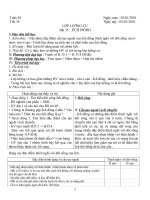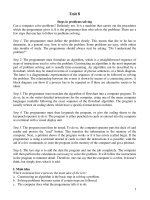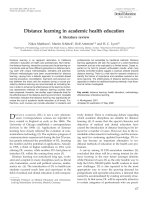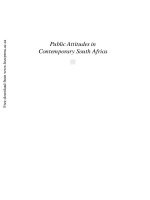Tài liệu Increasing Participation in Army Continuing Education - eArmyU and Effects of Possible Program Changes pptx
Bạn đang xem bản rút gọn của tài liệu. Xem và tải ngay bản đầy đủ của tài liệu tại đây (561.65 KB, 103 trang )
This PDF document was made available
from www.rand.org as a public service of
the RAND Corporation.
6
Jump down to document
Visit RAND at www.rand.org
Explore RAND Arroyo Center
View document details
This document and trademark(s) contained herein are protected by law
as indicated in a notice appearing later in this work. This electronic
representation of RAND intellectual property is provided for non-
commercial use only. Permission is required from RAND to reproduce, or
reuse in another form, any of our research documents.
Limited Electronic Distribution Rights
For More Information
CHILD POLICY
CIVIL JUSTICE
EDUCATION
ENERGY AND ENVIRONMENT
HEALTH AND HEALTH CARE
INTERNATIONAL AFFAIRS
NATIONAL SECURITY
POPULATION AND AGING
PUBLIC SAFETY
SCIENCE AND TECHNOLOGY
SUBSTANCE ABUSE
TERRORISM AND
HOMELAND SECURITY
TRANSPORTATION AND
INFRASTRUCTURE
The RAND Corporation is a nonprofit
research organization providing
objective analysis and effective
solutions that address the challenges
facing the public and private sectors
around the world.
Purchase this document
Browse Books & Publications
Make a charitable contribution
Support RAND
This product is part of the RAND Corporation monograph series.
RAND monographs present major research findings that address the
challenges facing the public and private sectors. All RAND mono-
graphs undergo rigorous peer review to ensure high standards for
research quality and objectivity.
Bruce R. Orvis, Laurie L. McDonald,
Barbara Raymond, Felicia Wu
Prepared for the United States Army
Approved for public release; distribution unlimited
Increasing
Participation in
Army Continuing
Education
eArmyU and Effects of Possible
Program Changes
The RAND Corporation is a nonprofit research organization providing
objective analysis and effective solutions that address the challenges
facing the public and private sectors around the world. RAND’s
publications do not necessarily reflect the opinions of its research clients
and sponsors.
R
®
is a registered trademark.
© Copyright 2005 RAND Corporation
All rights reserved. No part of this book may be reproduced in any
form by any electronic or mechanical means (including photocopying,
recording, or information storage and retrieval) without permission in
writing from RAND.
Published 2005 by the RAND Corporation
1776 Main Street, P.O. Box 2138, Santa Monica, CA 90407-2138
1200 South Hayes Street, Arlington, VA 22202-5050
201 North Craig Street, Suite 202, Pittsburgh, PA 15213-1516
RAND URL: />To order RAND documents or to obtain additional information, contact
Distribution Services: Telephone: (310) 451-7002;
Fax: (310) 451-6915; Email:
Library of Congress Cataloging-in-Publication Data
Increasing participation in Army continuing education : eArmyU and effects of possible
program changes /
Bruce R. Orvis [et al.].
p. cm.
“MG-293.”
Includes bibliographical references.
ISBN 0-8330-3708-0 (pbk.)
1. Soldiers—Education, Non-military—United States. 2. United States. Army. 3.
University extension—
United States. I. Orvis, Bruce R.
U716.I53 2005
378.1'758'08835500973—dc22
2004026796
The research described in this report was sponsored by the United States
Army under Contract No. DASW01-01-C-0003.
iii
Preface
This monograph presents the results of research on the eArmyU dis-
tance learning program. The project was requested by the Assistant
Secretary of the Army for Manpower and Reserve Affairs. The re-
search should interest policymakers concerned with the benefits and
costs of supporting soldiers through continuing education services.
The primary focus of this study is to help make eArmyU avail-
able to more individuals while controlling program costs. Prior to the
initiation of this study, eArmyU was offered to enlisted soldiers at 11
primary sites, with enrollment of approximately 30,000 soldiers. The
Army was interested in making the program available Army-wide, but
was concerned about the potential cost of doing so. Historically, the
incremental cost of eArmyU versus the Tuition Assistance program
has been attributed primarily to the laptop computer provided under
eArmyU. The strategy advanced by senior Army leaders was to reduce
costs by no longer funding the laptop. However, the effects of re-
moving the laptop or other eArmyU provisions were unknown. These
include (1) the willingness and ability of soldiers to participate and
(2) the effects of the current program and of possible program
changes on retention, on readiness and duty performance, and on the
quality of life for soldiers and their families. For this reason, laptop-
related issues receive the closest scrutiny in this research effort.
The research was conducted within RAND Arroyo Center’s
Manpower and Training Program. RAND Arroyo Center, part of the
RAND Corporation, is a federally funded research and development
center sponsored by the United States Army.
iv Increasing Participation in Army Continuing Education
For more information on RAND Arroyo Center, contact the
Director of Operations (telephone 310-393-0411, extension 6419;
FAX 310-451-6952; email ), or visit Ar-
royo’s web site at />v
Contents
Preface iii
Tables
vii
Summary
ix
Acknowledgments
xix
List of Acronyms
xxi
CHAPTER ONE
Introduction 1
Background
1
Study Purpose
3
Methodology
4
Pilot Test
4
Focus Groups
5
Personnel Records
7
Survey
7
How the Report Is Organized
9
CHAPTER TWO
Results 11
Participation in eArmyU
11
Characteristics of Current Program Participants
11
Alternative Programs
15
Retention
24
Duty Performance
26
Quality of Life
27
vi Increasing Participation in Army Continuing Education
What Soldiers Value Most About eArmyU and Areas for Improvement 27
What Is Valued Most
27
Mixed Reviews for Some Program Aspects
28
Recoupment Issues
30
CHAPTER THREE
Recommendations 33
Increase the Enlisted Force’s Access to Education Opportunities
33
Constrain eArmyU Costs per Soldier While Facilitating Access
34
Minimize a Soldier’s Risk of Recoupment in eArmyU
35
APPENDIX
A. Focus Group Protocols 37
B. Army Education Survey
53
C. Supplemental Data
61
D. Additional Input from the Education Center Staff Focus Groups
75
E. Informal Cost-Avoidance Analysis
77
Bibliography
79
vii
Tables
1. Crosswalk of Analysis Areas and Methods 9
2. Soldiers’ Likelihood of Participating in eArmyU
12
3. Prospective Participation in eArmyU
12
4. Participation Rates in Pilot Programs
16
5. Potential Participation Rates in eArmyU
18
6. Changes in Potential Participation Rates in eArmyU Given
Removal of Laptop Option
19
7. Changes in Potential Participation Rates in eArmyU Given
Required Purchase of Laptop
22
8. Difference in Months to Expiration of Term of Service by
Soldier Characteristics
25
C.1. Response Distributions for Survey Questions
61
C.2. Need Free Laptop to Participate in eArmyU
70
C.3. Means and Standard Deviations for Regression Variables
71
ix
Summary
Background
The United States Army offers a continuing education program
called eArmyU (an e-learning, computer-based program) that allows
enlisted soldiers to earn college credits and degrees at no or low cost
while they serve on active duty. eArmyU provides access to more than
90 online programs from more than 20 colleges and universities with
the credits being fully transferable among those institutions. The pro-
gram includes up to 100 percent funding for tuition, books, fees,
email, and an internet service provider (ISP). The current program
also provides a fully-funded personal laptop computer and a 24-hour/
7-day-a-week helpdesk. Participating schools must provide the maxi-
mum allowable credit for military training and experience as well as
for tests such as the CLEP (College Level Examination Program) (this
is not necessarily the case with unaffiliated schools). eArmyU also
provides an integrated online interface with all participating schools,
with common application and registration forms, a degree map cus-
tomized for the soldier that tracks his or her progress toward degrees,
an integrated searchable catalog from the schools, and library, tutor-
ing, and academic advisement services.
At the time of this study, to be eligible for the program, a soldier
had to complete a Service Remaining Requirement (SRR) of three
years, either through his or her current obligation or through exten-
x Increasing Participation in Army Continuing Education
sion of that obligation or reenlistment.
1
The enrollee in eArmyU also
had an obligation to successfully complete at least 12 semester hours
of courses during the first two years of enrollment.
At the time this research was requested, the Army offered the
eArmyU program at 11 primary sites
2
and had an enrollment of just
over 30,000 soldiers. The Army was interested in making the
eArmyU program available Army-wide, but was concerned about the
potential cost of doing so. At the beginning of FY03, a change in
DoD policy raised the maximum tuition assistance for continuing
education classes from 75 to 100 percent, eliminating an important
difference between these classes and those taken under eArmyU. As a
result, the incremental cost of eArmyU versus the tuition assistance
program was attributed primarily to the laptop provided under
eArmyU, and program administrators considered discontinuing
funding for the laptop in order to reduce eArmyU’s per-capita cost.
However, the effects of removing the laptop or other eArmyU provi-
sions were unknown. These effects can be categorized into four broad
issues: (1) the willingness and ability of soldiers to participate, (2) the
quality of life for soldiers and their families, (3) retention, and (4)
readiness and duty performance. In the remainder of this summary,
we outline the study methodology used, then move to a discussion of
the highlights of the study results.
RAND Arroyo Center Study Took a Multi-Method
Approach
To identify the potential effects of changes in the eArmyU program,
the study employed four complementary analytical approaches.
____________
1
The criteria for eligibility are currently under review. Throughout this document, the “cur-
rent” program refers to the program benefits and eligibility requirements described here
(those in effect at the time of this study).
2
Primary sites offer enrollments and support to the eArmyU program. Soldiers may be reas-
signed to other locations and take the program with them, though support is slightly differ-
ent in these instances.
Summary xi
First, there was a pilot test of alternative eArmyU programs
across nine test sites: three sites offering the current program, three
(current) sites offering a laptop-optional program, and three (new)
sites offering a no-laptop program.
Second, to gather detailed information about eArmyU, 10 focus
groups were conducted at the test sites during two-day visits.
3
These
included six groups of soldier-eArmyU students, two groups of their
immediate supervisors, and two groups of eArmyU counselors and
administrators.
Third, personnel records were analyzed to describe how enrol-
lees in eArmyU differ from nonenrollees and to assess the retention
effects of the current version of eArmyU. This included assessing the
mix of enrollees among those already meeting the SRR, those ex-
tending, or those reenlisting and the overall impact on years of service
remaining.
Fourth, 8,000 enlisted soldiers were randomly selected to par-
ticipate in a survey of educational aspirations (including their poten-
tial interest in eArmyU and other education programs), their Army
career plans, and the linkage between the two.
The pilot test was initiated on January 27, 2003. Site visits and
focus groups began on March 5.
Results
The study results cover four primary areas: participation, retention,
duty performance, and quality of life. In addition, the focus groups
provided an opportunity to explore the value that soldiers attach to
the various elements of the eArmyU program as well as to ask pro-
gram administrators about issues concerning qualification standards
____________
3
Originally, focus groups were to be conducted at each of the nine test sites. This became
impractical at three of the sites due to preparations for and deployments related to Operation
Iraqi Freedom (OIF) as well as low enrollment rates at two of the no-laptop sites (related in
part to OIF). Video conferences were conducted with the Education Center staffs at these
sites in lieu of the site visits.
xii Increasing Participation in Army Continuing Education
for eArmyU program participation. Below, we provide an overview of
the points raised in those discussions.
Participation
Who has been most likely to enroll in the traditional eArmyU pro-
gram? According to the study results analyzing eArmyU records,
those especially likely to enroll include:
• African American soldiers,
• female soldiers,
• AFQT Category I–IIIA soldiers (average to above-average intel-
ligence levels),
• married soldiers,
• soldiers with dependents, and
• senior soldiers (especially E6–E7).
The survey further indicates that soldiers planning to reenlist or
stay until retirement; those having three or more years to their expira-
tion of term of service (ETS); those wanting two years or more of
college or a degree; those already continuing their education or plan-
ning to enroll soon; those believing obtaining more education is im-
portant to the ability to compete within their military careers or for a
civilian job; those confident in their ability to undertake or who pre-
fer online courses; soldiers thinking of leaving the Army for more
time with their families; those having a home computer (57 percent);
and those needing the free laptop to participate (90 percent say it
would help greatly, 52 percent say it is critical) would be more likely
to enroll in the current program.
The pilot test results clearly show that the fully-funded laptop is
a very important element underlying soldiers’ participation in
eArmyU. If the laptop is optional, most soldiers will choose to take it,
at least in the near term. If the laptop is not provided, eArmyU par-
ticipation rates are likely to decline significantly. Although the overall
pattern of results is clearly downward, the specific numbers in the
pilot test results should be interpreted with caution. Procedural and
deployment issues occurred during the pilot test that would not
Summary xiii
similarly affect a future Army-wide roll-out of the program. These
were, most notably, screening procedures for participation, awareness
of the laptop program, and Iraq-related deployments. It is possible
that the pilot test underestimates the actual take-rate that might be
seen.
Indeed, the survey results show greater potential participation
rates than the pilot test for the no-laptop version of eArmyU. These
results suggest that over time, participation rates with the laptop op-
tion might grow to two-thirds or more of eligible soldiers, whereas
without the laptop option, participation rates might top out at one-
third to one-half, depending on whether soldiers could use their own
computers or had to buy the laptop currently provided by the Army.
The results also indicate that soldiers currently continuing their edu-
cation, those needing the laptop to participate in eArmyU (e.g.,
young soldiers, minorities), those concerned with pay or time away
from their family, and male soldiers would be particularly adversely
affected by removal of the laptop. Soldiers wanting only a limited
amount of college or who have only 1–2 years of service until their
ETS are more open to the “no-laptop” option than others.
Results from the focus groups indicate that soldiers would like
the option of choosing or not choosing the laptop. Many soldiers
need the laptop to participate, and soldiers also stress the benefits of
its portability. Some find they can continue their classes while on de-
ployments, training exercises, or temporary duty (TDY). At the same
time, some don’t need the laptop and would welcome the reduced
SRR or course requirements to reduce the commitment and possibil-
ity of recoupment.
4
Others want more courses than the $4,500 an-
nual tuition assistance cap allows after deduction of the technology
package; this includes senior soldiers wanting a degree before retire-
ment.
____________
4
If the semester hour obligation is not met, eArmyU’s recoupment policy requires that the
soldier pay a prorated share of the cost of the laptop based on the portion of the requirement
not completed. The recoupment policy also requires payment of tuition costs for any failed
courses.
xiv Increasing Participation in Army Continuing Education
Retention
Personnel records from the Total Army Personnel Data Base
(TAPDB) and eArmyU files indicate that the current eArmyU pro-
gram is associated with increased retention. Specifically, the TAPDB
shows that eArmyU participants have one year longer to their ETS
date than demographically similar nonparticipants, and analysis of
eArmyU records shows that 25 to 30 percent of the participants ex-
tend or reenlist to participate. The survey results are generally consis-
tent with the finding from the personnel record analysis of longer
time to ETS for program participants. They also show that soldiers
planning to reenlist or stay to retirement are more interested in
eArmyU than those planning to leave the Army soon. Focus group
discussions with participants also reflect this mix of greater commit-
ment to an Army career with extensions or reenlistments specifically
made to participate in eArmyU. Soldiers are motivated both by im-
proving their in-service promotion opportunities as well as their post-
service earnings. Some who reenlisted or extended for eArmyU indi-
cated that they would have done so in the absence of eArmyU,
whereas others reported that they extended/reenlisted primarily for
eArmyU. Considering the frequency of extensions and reenlistments,
the time added to ETS by each, and the fraction of soldiers reporting
that they extended/reenlisted in order to participate, the extensions
and reenlistments appear to account for up to half of the overall dif-
ference in time to ETS.
Duty Performance
Many focus group participants report using their laptops to assist
them in performing their duties. They primarily report using them to
help process paperwork at home and, for fewer soldiers, at their duty
locations. They can also be used on deployments or TDYs in some
cases. For junior soldiers or those in more combat-oriented military
occupational specialties (MOSs), the eArmyU laptop may be the only
computer readily available to them at their duty location or home.
Some soldiers and supervisors report improved duty performance
from eArmyU classes, participation, or equipment, but this is less
Summary xv
typical. Supervisors generally say they support continued education;
they report little interference with performance of duties.
Quality of Life
Many focus group participants report using their eArmyU laptop and
ISP routinely to meet personal needs or desires. These include getting
work done while spending time with their family, getting information
through the Internet, contacting family members or friends, and pro-
viding computer access to other family members (including for their
schooling or jobs). Some focus group members also cite the impor-
tance of the laptop when traveling for the Army or when on leave.
Uses include both tasks done locally on the laptop and via Internet
connections.
What Do Soldiers Value About eArmyU?
Soldiers indicate that what they value most about eArmyU is its flexi-
bility—they are able to fit in their education around work, family,
field training, and other activities. Tuition assistance is also deemed
important by soldiers, as are the free books and delivery. While many
soldiers reported that the Army-provided laptop is very important,
many also use their own computers (unless on travel, when the laptop
and ISP are more highly valued). The Army-provided ISP is more
important for soldiers who live in barracks; many older soldiers have
their own ISP, DSL, or cable service.
Soldiers noted that withdrawing laptops may not be cost free,
since the Army may need to monitor and maintain approved on-post
computers. They also note the possibility of using the eArmyU laptop
or ISP to facilitate completion of NCO courses online or with CDs,
or to access Army Knowledge Online, thus reducing the need for
other resources for these purposes. Opportunity costs of not provid-
ing the free laptop on quality of life and duty performance would
need to be accounted for, as would any cost implications of addi-
tional time or staff required if soldiers were not able to use the laptop
to help keep current on their duties.
xvi Increasing Participation in Army Continuing Education
Qualification Standards
Soldiers and Education Center staffs both suggested the need for
qualification standards for eArmyU. These could include a minimum
aptitude level (General Technical (GT) score from the Armed Serv-
ices Vocational Aptitude Battery) and reading grade level; a proven
ability to complete college courses or required initial completion of
attendance-based or online classes; a placement test to demonstrate
computer literacy or a required initial course; a delay in eligibility so
junior soldiers can first gain some Army experience to understand
their job requirements; and the possibility of requiring an upfront fee
to discourage enrollments by soldiers who enroll primarily for laptops
or who have not thought through the required commitment to com-
plete their courses and avoid recoupment.
5
Recommendations
The Army has outlined several key goals for the eArmyU program.
We organize our recommendations by the overarching Army goal
that they support.
Goal: Increase enlisted access to education opportunities
To help increase enlisted access to continuing education opportuni-
ties, we recommend that the Army open eArmyU to enrollments at
more sites, and, eventually, at all posts. It should consider basing the
slots allocated to each post on the post’s E4–E9 population less cur-
rent enrollees. We recommend that eArmyU retain its highly valued
core features: tuition assistance, free books and delivery, and the
common internet interface. To avoid constraining participation
among junior soldiers or those with financial challenges, options for
an Army-funded laptop and ISP should be included.
____________
5
Soldiers who do not complete their semester hour or service remaining requirement are
required to reimburse the Army for the value of a prorated share of the laptop cost corre-
sponding to the portion of the 12 semester hours/SRR not completed.
Summary xvii
Goal: Constrain eArmyU costs to facilitate increased enlisted access
We recommend offering soldiers more options that increase the flexi-
bility of eArmyU for them while controlling costs. These could in-
clude options that encourage soldiers not to take unnecessary tech-
nology features (laptop or ISP) by reducing requirements (SRR,
semester hours) for more limited packages but maintaining eligibility
(three years or until ETS if sooner). Soldiers also should be discour-
aged from taking laptop or ISP features they do not need by having
to share costs, for example, by their inclusion in the tuition cap or by
initial co-payment. The impact of cost-sharing on more advanced
students could be offset by considering graduated tuition assistance
caps based on costs for different degrees and courses. The Army could
also facilitate continuity of education by improving transferability of
credits into eArmyU from other online programs, or to other online
programs after completion of eArmyU coursework.
Goal: Limit soldiers’ risk of recoupment in eArmyU
We recommend that realistic, thorough information be provided to
soldiers up front on the challenges as well as opportunities of
eArmyU (by counselors, existing students, and supervisors). We rec-
ommend enhancing supervisors’ and Education Center staff’s ability
to track a soldier’s progress and intervene if needed to help the soldier
avoid the need for recoupment.
We also recommend establishing and enforcing prerequisites
that enhance a soldier’s likelihood of success in eArmyU. After discus-
sions with the Education Center staff members at the current sites,
eArmyU administrators should agree on and enforce a qualification-
based procedure to fill the slots. As noted, the prerequisites could in-
clude thresholds for GT score and reading grade level; the proven
ability to complete college courses in the past or required completion
of initial attendance-based classes, online classes, or both; a placement
test to demonstrate computer literacy or a required course; a mini-
mum time in service or a minimum pay grade (for example, E4); and
reducing ill-advised enrollments by requiring limited initial co-
payment (amount to be determined, based on affordability, course
enrollment, and technology options).
xix
Acknowledgments
We would like to express our gratitude to the numerous people in
offices across the Army who have made significant contributions to
this research. They include those in our client office, the Office of the
Assistant Secretary of the Army for Manpower and Reserve Affairs;
Headquarters, Army Continuing Education System; the Education
Center staffs at our pilot test and focus group sites; and the Army Re-
search Institute. At RAND, we are grateful to Jerry Sollinger, Martha
Friese, and Karin Suede for their assistance in the preparation of this
report. We also gratefully acknowledge the helpful comments pro-
vided by our peer reviewers, Matt Lewis and J.D. Eveland.
xxi
List of Acronyms
ACES Army Continuing Education Services
AFQT Armed Forces Qualification Test
AKO Army Knowledge Online
CLEP College Level Examination Program
EDMIS Education Management Information System
ETS Expiration of Term of Service
FY Fiscal Year
GT General Technical
HSG High School Graduate
ISP Internet Service Provider
MOS Military Occupational Specialty
NCO Noncommissioned Officer
OIF Operation Iraqi Freedom
OML Order of Merit List
PA Participation Agreement
SRR Service Remaining Requirement
TA Tuition Assistance
xxii Increasing Participation in Army Continuing Education
TAPDB Total Army Personnel Data Base
TDY Temporary Duty
1
CHAPTER ONE
Introduction
Background
The Army offers a continuing education program called eArmyU (an
e-learning, computer-based program) that allows soldiers to earn col-
lege credits and degrees at no or low cost while on active duty. The
name eArmyU was chosen to emphasize the electronic, online aspect
of the program. eArmyU provides access to more than 90 online
degree-granting programs from more than 20 colleges and universi-
ties. The program provides up to 100 percent funding for tuition,
books, fees, email, and an internet service provider (ISP). The current
program also provides a fully-funded personal laptop computer and a
24-hour/7-day-a-week telephone-based helpdesk.
All participating schools must provide maximum credit
1
for
military training and experience and also for tests such as the CLEP
(College Level Examination Program). eArmyU also provides an in-
tegrated online interface to all schools, with common application and
registration forms, a degree map customized for the soldier to track
his or her progress toward the degree of choice, an integrated search-
able catalog from the schools, and library, tutoring, and academic ad-
visement services.
At the time of this study, to be eligible for the program the sol-
dier had to meet a service remaining requirement (SRR) of three years
and complete at least 12 semester hours during the first two years of
____________
1
Schools not participating in eArmyU vary in crediting Army courses/experience.









